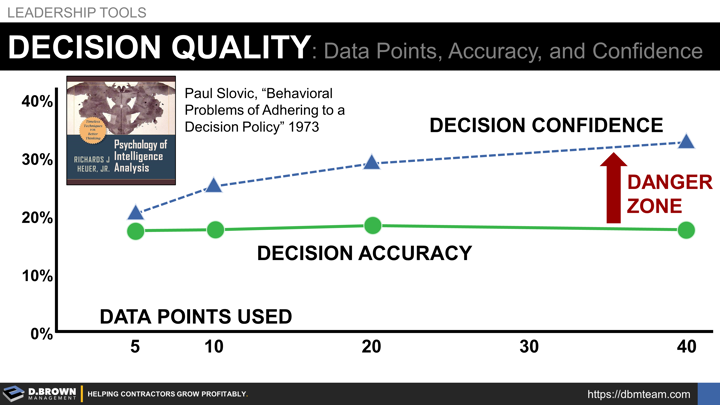Running a contracting business is considered a “complex environment” with many variables completely outside your control so this is an important concept. This DOES NOT mean that information does not matter when making decisions.
In an engineering calculation with known variables, the more you can account for the more accurate the engineering calculation becomes. You can and should become MORE CONFIDENT in your calculation.
This graph is from studies done by Paul Slovic - Behavioral Problems of Adhering to a Decision Policy. Many similar studies have been done in a variety of fields including safety.
This particular data set was created by asking experienced horse handicappers to identify their top 40 pieces of information they looked at to identify their bet on first place finishers. They then asked them for their top 20, top 10, and top 5 lists of data points.
They tracked decisions made over time with each of them having different quantities of information at different points in time. The outcomes were approximately the same for all levels of data they used, and in this case, 20% was a good decision as it was about how much to handicap.
The problem is that as they had more data points, their confidence in the decision continued to increase. You put yourself in a danger zone if your confidence exceeds the actual quality of the decision because you will risk too much and/or work to mitigate too little.
Think about the bets you make as a contractor:
- Decision to pursue an opportunity.
- Production rates used in an estimate.
- Markup you put on that cost estimate based on risk and competition variables.
- Strategic market choices - will your big bets pay off?
- Will this person be able to do what we think based on our hiring process?
- Does this consultant know what they are talking about? :)
Annie Duke describes luck, risk, and mitigation very well.
Think about playing poker where you have both luck and skill involved. In this situation, more information will only yield better results up to a point and beyond that the only thing that goes up is your confidence in the decision.
Organizations ranging from the CIA to law enforcement to investors all have to make probabilistic predictions about ambiguous situations with incomplete data. It is worth studying a little bit about their approaches, including how to put systems in place to work against normal human cognitive biases and logical fallacies.
The Psychology of Intelligence Analysis
NOTHING is more DANGEROUS than a high degree of confidence in a decision that only has a 20% probability of being right. That is what causes people to stick to bad decisions instead of pivoting quickly.
What matters more is making the best decisions you can then checking the results frequently making adjustments as necessary.

